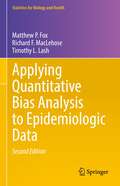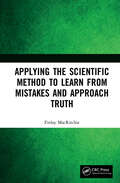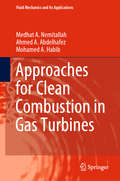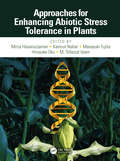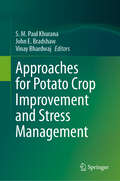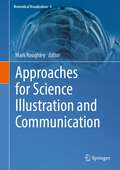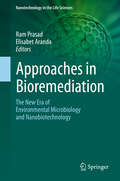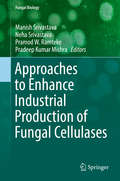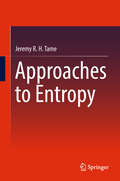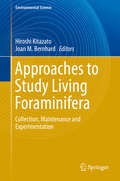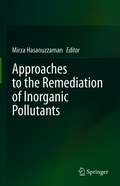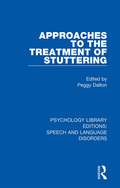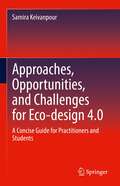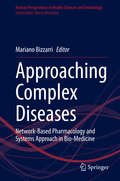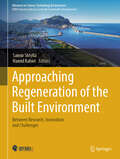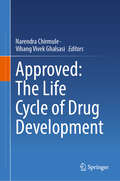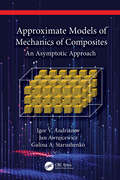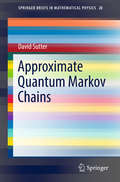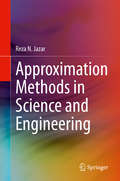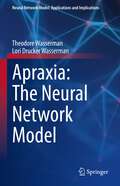- Table View
- List View
Applying Quantitative Bias Analysis to Epidemiologic Data (Statistics for Biology and Health)
by Matthew P. Fox Timothy L. Lash Richard F. MacLehoseThis textbook and guide focuses on methodologies for bias analysis in epidemiology and public health, not only providing updates to the first edition but also further developing methods and adding new advanced methods. As computational power available to analysts has improved and epidemiologic problems have become more advanced, missing data, Bayes, and empirical methods have become more commonly used. This new edition features updated examples throughout and adds coverage addressing: Measurement error pertaining to continuous and polytomous variables Methods surrounding person-time (rate) data Bias analysis using missing data, empirical (likelihood), and Bayes methods A unique feature of this revision is its section on best practices for implementing, presenting, and interpreting bias analyses. Pedagogically, the text guides students and professionals through the planning stages of bias analysis, including the design of validation studies and the collection of validity data from other sources. Three chapters present methods for corrections to address selection bias, uncontrolled confounding, and measurement errors, and subsequent sections extend these methods to probabilistic bias analysis, missing data methods, likelihood-based approaches, Bayesian methods, and best practices.
Applying the Scientific Method to Learn from Mistakes and Approach Truth
by Finlay MacRitchieIn its simplest form, the scientific method can be thought of as learning from our mistakes and trying to correct them. True scientists try to think rationally, never adopt dogmatic opinions and are always willing to listen to opposing views. They never claim to know the absolute truth but are relentless in their search for it. In this timely book, the author describes the fundamentals of critical scientific thinking. The book further examines the correct use of the scientific method and how to apply it to current events and scientific topics to obtain honest assessments. Current controversies discussed include climate change and COVID-related lockdowns.Additional Features include: Demonstrates the use of the scientific method to assist with objective analysis of issues Addresses that induction plays a role but the true method for advancing knowledge is hypothesis-deduction Explores current hot topics within the framework of the scientific method Outlines common misunderstandings of the scientific method Applying the Scientific Method to Learn from Mistakes and Approach Truth is approachable enough for the general public and recommended for university and advanced high school science educators and their students.
Approaches for Clean Combustion in Gas Turbines (Fluid Mechanics and Its Applications #122)
by Medhat A. Nemitallah Mohamed A. Habib Ahmed A. AbdelhafezThis book focuses on the development of novel combustion approaches and burner designs for clean power generation in gas turbines. It shows the reader how to control the release of pollutants to the environment in an effort to reduce global warming. After an introduction to global warming issues and clean power production for gas turbine applications, subsequent chapters address premixed combustion, burner designs for clean power generation, gas turbine performance, and insights on gas turbine operability. Given its scope, the book can be used as a textbook for graduate-level courses on clean combustion, or as a reference book to accompany compact courses for mechanical engineers and young researchers around the world.
Approaches for Ecosystem Services Valuation for the Gulf of Mexico After the Deepwater Horizon Oil Spill
by Committee on the Effects of the Deepwater Horizon Mississippi Canyon-252 Oil Spill on Ecosystem Services in the Gulf of MexicoOn April 20, 2010, the Deepwater Horizon platform drilling the Macondo well in Mississippi Canyon Block 252 (DWH) exploded, killing 11 workers and injuring another 17. The DWH oil spill resulted in nearly 5 million barrels (approximately 200 million gallons) of crude oil spilling into the Gulf of Mexico (GoM). The full impacts of the spill on the GoM and the people who live and work there are unknown but expected to be considerable, and will be expressed over years to decades. In the short term, up to 80,000 square miles of the U. S. Exclusive Economic Zone (EEZ) were closed to fishing, resulting in loss of food, jobs and recreation. The DWH oil spill immediately triggered a process under the U. S. Oil Pollution Act of 1990 (OPA) to determine the extent and severity of the "injury" (defined as an observable or measurable adverse change in a natural resource or impairment of a natural resource service) to the public trust, known as the Natural Resources Damage Assessment (NRDA). The assessment, undertaken by the trustees (designated technical experts who act on behalf of the public and who are tasked with assessing the nature and extent of site-related contamination and impacts), requires: (1) quantifying the extent of damage; (2) developing, implementing, and monitoring restoration plans; and (3) seeking compensation for the costs of assessment and restoration from those deemed responsible for the injury. This interim report provides options for expanding the current effort to include the analysis of ecosystem services to help address the unprecedented scale of this spill in U. S. waters and the challenges it presents to those charged with undertaking the damage assessment.
Approaches for Enhancing Abiotic Stress Tolerance in Plants
by Masayuki Fujita Mirza Hasanuzzaman Hirosuke Oku Kamrun Nahar Tofazzal IslamPlants are frequently exposed to unfavorable and adverse environmental conditions known as abiotic stressors. These factors can include salinity, drought, heat, cold, flooding, heavy metals, and UV radiation which pose serious threats to the sustainability of crop yields. Since abiotic stresses are major constraints for crop production, finding the approaches to enhance stress tolerance is crucial to increase crop production and increase food security. This book discusses approaches to enhance abiotic stress tolerance in crop plants on a global scale. Plants scientists and breeders will learn how to further mitigate plant responses and develop new crop varieties for the changing climate.
Approaches for Potato Crop Improvement and Stress Management
by John E. Bradshaw S. M. Paul Khurana Vinay BhardwajThis edited book provides an all-inclusive coverage of latest research in crop improvement and stress management in potato crop. It is composed of 17 chapters covering breeding, diseases & pest management with the view to enhancing the total production and quality under the scenario of climate change. The book also explores harvesting, storage, post-harvest management, and processing of potato. The book has special focus on the use of high throughput next generation sequencing (NGS) techniques, modern genomics tools, genome editing techniques such as CRISPR systems that could help the potato breeding programs and, also in development of biotic and abiotic stress resistant varieties. Potato is the world’s third most important food crop after wheat and rice in terms of human consumption. It is the staple crop providing maximum nutrients per unit area, time and money and is the most versatile crop with the highest industrial production potential in India being the second largest potato producing country after China. As a major food crop, the potato has the most important role to play in the United Nations’ Sustainable Development Goals’ 2030 Agenda for zero hunger, achieving food security, improved nutrition, and promote sustainable agriculture. This book is unique in its approach for providing in depth knowledge enabling readers to learn the subject fully on different strategies, new perspectives and fully understanding different topics of diversity, interaction and improvement for stress management in potato. It is a relevant reading material for researchers, students, practitioners and other stakeholders involved in improvement of potato crop.
Approaches for Science Illustration and Communication (Biomedical Visualization #4)
by Mark RoughleyThis edited book explores the breadth of approaches undertaken by scientists, artists and communicators in their crucial role making science accessible, engaging and impactful. Contemporary approaches in science illustration and visualization include a variety of creative methodologies that are valuable for effective communication, teaching, learning and professional practice. These range in method from anatomical drawings used in medical curricula, to 2D animations and editorial illustrations available in the public realm. They also include unexpected approaches such as the use of tabletop board games, comics and collage in understanding our bodies, emergent health threats and cutting-edge science developments. If you are a scientist seeking to enhance your ability to communicate your research or an artist interested in biomedical visualization, this volume serves as an introduction to contemporary approaches in science illustration and communication. By understanding the creative methods and techniques employed in this field, we can collectively work towards fostering a deeper appreciation of art in science, and continue to captivate and inspire audiences worldwide.
Approaches in Bioremediation: The New Era of Environmental Microbiology and Nanobiotechnology (Nanotechnology in the Life Sciences)
by Ram Prasad Elisabet ArandaBioremediation refers to the clean‐up of pollution in soil, groundwater, surface water, and air using typically microbiological processes. It uses naturally occurring bacteria and fungi or plants to degrade, transform or detoxify hazardous substances to human health or the environment.For bioremediation to be effective, microorganisms must enzymatically attack the pollutants and convert them to harmless products. As bioremediation can be effective only where environmental conditions permit microbial growth and action, its application often involves the management of ecological factors to allow microbial growth and degradation to continue at a faster rate. Like other technologies, bioremediation has its limitations. Some contaminants, such as chlorinated organic or high aromatic hydrocarbons, are resistant to microbial attack. They are degraded either gradually or not at all, hence, it is not easy to envisage the rates of clean-up for bioremediation implementation.Bioremediation represents a field of great expansion due to the important development of new technologies. Among them, several decades on metagenomics expansion has led to the detection of autochthonous microbiota that plays a key role during transformation. Transcriptomic guides us to know the expression of key genes and proteomics allow the characterization of proteins that conduct specific reactions. In this book we show specific technologies applied in bioremediation of main interest for research in the field, with special attention on fungi, which have been poorly studied microorganisms. Finally, new approaches in the field, such as CRISPR-CAS9, are also discussed. Lastly, it introduces management strategies, such as bioremediation application for managing affected environment and bioremediation approaches. Examples of successful bioremediation applications are illustrated in radionuclide entrapment and retardation, soil stabilization and remediation of polycyclic aromatic hydrocarbons, phenols, plastics or fluorinated compounds. Other emerging bioremediation methods include electro bioremediation, microbe-availed phytoremediation, genetic recombinant technologies in enhancing plants in accumulation of inorganic metals, and metalloids as well as degradation of organic pollutants, protein-metabolic engineering to increase bioremediation efficiency, including nanotechnology applications are also discussed.
Approaches to Enhance Industrial Production of Fungal Cellulases (Fungal Biology)
by Neha Srivastava Manish Srivastava Pramod W. Ramteke Pradeep Kumar MishraCellulase is a key enzyme of industrial interest and plays a crucial role in the hydrolysis of cellulose, a prime component of plant cell walls. Cellulase covers a broad area in the global market of industrially important enzymes and it is considered as the third largest industrial enzyme globally. Additionally, cellulase contributes about 20% of the total enzyme market globally because of its massive demand in various industries such as in biofuel production, pulp, paper, textile, food, and beverages, as well as in detergent industries. Among these, the demand of cellulase may become frequently selected in the commercial production of biofuels in the future and thus will further increase demand of cellulase in the biofuel industry. Because biofuel production is still not realized in a cost-effective, practical implementation due to its high cost (the higher cost of biofuels is due to higher production costs of enzymes), there is a need to introduce these types of approaches, which will help to lower the cost of enzyme production for developing overall economic biofuel production.
Approaches to Entropy
by Jeremy R. TameThis is a book about thermodynamics, not history, but it adopts a semi-historical approach in order to highlight different approaches to entropy. The book does not follow a rigid temporal order of events, nor it is meant to be comprehensive. It includes solved examples for a solid understanding. The division into chapters under the names of key players in the development of the field is not intended to separate these individual contributions entirely, but to highlight their different approaches to entropy. This structure helps to provide a different view-point from other text-books on entropy.
Approaches to Future Space Cooperation and Competition in a Globalizing World: Summary of a Workshop
by National Research Council of the National AcademiesNumerous countries and regions now have very active space programs, and the number is increasing. These maturing capabilities around the world create a plethora of potential partners for cooperative space endeavors, while at the same time heightening competitiveness in the international space arena. This book summarizes a public workshop held in November 2008 for the purpose of reviewing past and present cooperation, coordination, and competition mechanisms for space and Earth science research and space exploration; identifying significant lessons learned; and discussing how those lessons could best be applied in the future, particularly in the areas of cooperation and collaboration. Presentations and initial discussion focused on past and present experiences in international cooperation and competition to identify "lessons learned." Those lessons learned were then used as the starting point for subsequent discussions on the most effective ways for structuring future cooperation or coordination in space and Earth science research and space exploration. The goal of the workshop was not to develop a specific model for future cooperation or coordination, but rather to explore the advantages and disadvantages of various approaches and stimulate further deliberation on this important topic.
Approaches to Study Living Foraminifera: Collection, Maintenance and Experimentation (Environmental Science and Engineering)
by Hiroshi Kitazato Joan M. BernhardForaminiferal cultures now serve as tools for researching biological, environmental, and geological topics. However, the biological backgrounds, in particular the natural histories of foraminifera, largely remain unclear. It is also true that the different techniques used in different subdisciplines are a setback to fully understanding the subject. Taken together, these factors prevent progress in experimental approaches to foraminiferal studies. This book aims to share and exchange knowledge between researchers from different subdisciplines, and the book should interest not only foraminiferal researchers but also scientists who are working with marine organisms to explore questions in relation to biology, geology, and oceanography.
Approaches to the Conformational Analysis of Biopharmaceuticals (Protein Science)
by Roger L. LundbladThe activity of many biopharmaceutical polymers is dependent on conformation, and the next several years will see increased interest in the conformational analysis of these polymers resulting from the development of biosimilar or "follow-on" biological products. While a wide variety of approaches to analysis exists, finding the most viable ones wou
Approaches to the Evolution of Language: Language in Prehistory
by Alan BarnardFor ninety per cent of our history, humans have lived as 'hunters and gatherers', and for most of this time, as talking individuals. No direct evidence for the origin and evolution of language exists; we do not even know if early humans had language, either spoken or signed. Taking an anthropological perspective, Alan Barnard acknowledges this difficulty and argues that we can nevertheless infer a great deal about our linguistic past from what is around us in the present. Hunter-gatherers still inhabit much of the world, and in sufficient number to enable us to study the ways in which they speak, the many languages they use, and what they use them for. Barnard investigates the lives of hunter-gatherers by understanding them in their own terms, to create a book which will be welcomed by all those interested in the evolution of language.
Approaches to the Remediation of Inorganic Pollutants
by Mirza HasanuzzamanIn this comprehensive book, plant biologists and environmental scientists present the latest information on different approaches to the remediation of inorganic pollutants. Highlighting remediation techniques for a broad range of pollutants, the book offers a timely compilation to help readers understand injury and tolerance mechanisms, and the subsequent improvements that can be achieved by plant-based remediation. Gathering contributions by respected experts in the field, the book represents a valuable asset for students and researchers, particularly plant physiologists, environmental scientists, biotechnologists, botanists, soil chemists and agronomists.
Approaches to the Treatment of Stuttering (Psychology Library Editions: Speech and Language Disorders)
by Peggy DaltonIn the years prior to publication ‘cures’ for stuttering seemed to appear constantly, but many were of limited value, were poorly evaluated and gave only a temporary alleviation that was not transferred to daily life. More responsible clinicians produced publications expounding one particular approach to therapy but less was available giving a balanced overview which was of practical help to therapists. Originally published in 1983, this book aimed to provide such an overview, with a focus on practical intervention rather than on theory. The need for careful assessment is particularly stressed and also the need for flexibility in the choice of treatment for any one client. Changes in fluency are looked at in relation to the effects they might have on the person’s life as a whole and factors involved in the maintenance of this change are discussed. In addition, adjuncts to speech therapy, such as drugs, hypnosis and various forms of masking are evaluated. Issues of the training of therapists are raised and suggestions made as to the nature of the therapeutic relationship when working with people who stutter.
Approaches, Opportunities, and Challenges for Eco-design 4.0: A Concise Guide for Practitioners and Students
by Samira KeivanpourThis book addresses the implications of the Industry 4.0 paradigm in design for the environment. We examine the opportunities for, and challenges of, the implications of cyber-physical systems, big data analytics, Internet of things, additive manufacturing, and simulation in a range of areas in an eco-design context. These include selecting low impact materials, choosing manufacturing processes with environmental considerations, end of life strategies, applying design approaches for disassembly, integrating economic and social components into environmental studies, and stakeholder’s involvement. This volume takes a step toward this journey to explore how the three pillars of technology, sustainability, and evolving consumers could shape the future of the product’s design.
Approaching Complex Diseases: Network-Based Pharmacology and Systems Approach in Bio-Medicine (Human Perspectives in Health Sciences and Technology #2)
by Mariano BizzarriThis volume – for pharmacologists, systems biologists, philosophers and historians of medicine – points to investigate new avenues in pharmacology research, by providing a full assessment of the premises underlying a radical shift in the pharmacology paradigm. The pharmaceutical industry is currently facing unparalleled challenges in developing innovative drugs. While drug-developing scientists in the 1990s mostly welcomed the transformation into a target-based approach, two decades of experience shows that this model is failing to boost both drug discovery and efficiency. Selected targets were often not druggable and with poor disease linkage, leading to either high toxicity or poor efficacy. Therefore, a profound rethinking of the current paradigm is needed. Advances in systems biology are revealing a phenotypic robustness and a network structure that strongly suggest that exquisitely selective compounds, compared with multitarget drugs, may exhibit lower than desired clinical efficacy. This appreciation of the role of polypharmacology has significant implications for tackling the two major sources of attrition in drug development, efficacy and toxicity. Integrating network biology and polypharmacology holds the promise of expanding the current opportunity space for druggable targets.
Approaching Regeneration of the Built Environment: Between Research, Innovation and Challenges (Advances in Science, Technology & Innovation)
by Saimir Shtylla Hamid RabieiThis book approaches three important aspects related with urban regeneration such as research, innovation and challenges. In light of its growing interdisciplinarity, the selected contributions extend the debate to the importance of the cooperation between various disciplines, attention to the latest design and technological trends, as well major inclusivity of citizens for a correct decision-making process leading afterwards into successful development, test and implementation of innovative solutions. An important focus will be set on the important role innovations play in the preservation and management of heritage sites in response to the climate and urban challenges encountered. Also, this contribution aims to transmit the importance of local interventions in the achievement of urban regeneration as an impulse for the achievement of the common global climate goals in the years ahead.
Appropriate Technology in Vector Control
by Christopher F. CurtisThis book was first published in 1990. It discusses a plethora of both high and low tech options for the control of vectors such as mosquitos in the spread of disease.
Approved: The Life Cycle of Drug Development
by Narendra Chirmule Vihang Vivek GhalsasiDrug development stands at a transformative threshold in modern medicine. Over the past three decades, biotherapeutics have redefined medical innovation, paving the way for treatments that are not only effective but also accessible. This book provides a comprehensive exploration of the intricate world of drug development, shedding light on the essential balance between efficiency, regulatory compliance, and quality to achieve both innovation and affordability. Written by leading experts, this guide delves into the multi-faceted process of drug development, covering critical areas such as pharmacology, biomarkers, toxicology, product development, manufacturing, and clinical trials—all framed within the stringent requirements set by the FDA. Readers will find in-depth discussions on the latest technologies, statistical approaches, and quality assurance measures essential to navigating today’s complex regulatory landscape. With practical case studies, project reports, and curated article reviews, this book offers valuable insights into risk assessment and mitigation at every stage of development. It serves as an indispensable resource for students, educators, and industry professionals, aiming to foster a deeper understanding of the challenges and opportunities in drug development and to inspire the next generation of scientific innovators.
Approximate Models of Mechanics of Composites: An Asymptotic Approach
by Jan Awrejcewicz Igor V. Andrianov Galina A. StarushenkoApproximate Models of Mechanics of Composites: An Asymptotic Approach is an essential guide to constructing asymptotic models and mathematical methods to correctly identify the mechanical behavior of composites. It provides methodology for predicting and evaluating composite behavior in various structures, leading to accurate mathematical and physical assessments. The book estimates the error of approximations through comparing asymptotic solutions with the results of numerical and analytical solutions to gain a holistic view of the data. The authors have developed asymptotic models based on mathematical and physical rigorous approaches, which include three-phase models of fibrous composites, a modernized three-phase composite model with cylindrical inclusions, and models of two-dimensional composites of hexagonal structure. Also covered are two-phase models of composites related to the Maxwell formula and a percolation transition model for elastic problems based on the self-consistency method and Padé approximations. By obtaining analytical expressions to effectively characterize composite materials, their physical and geometric parameters can be accurately assessed. This book suits engineers and students working in material science, mechanical engineering, physics, and mathematics, as well as composite materials in industries such as construction, transport, aerospace, and chemical engineering.
Approximate Quantum Markov Chains (SpringerBriefs In Mathematical Physics #28)
by David SutterThis book is an introduction to quantum Markov chains and explains how this concept is connected to the question of how well a lost quantum mechanical system can be recovered from a correlated subsystem. To achieve this goal, we strengthen the data-processing inequality such that it reveals a statement about the reconstruction of lost information. <P><P> The main difficulty in order to understand the behavior of quantum Markov chains arises from the fact that quantum mechanical operators do not commute in general. As a result we start by explaining two techniques of how to deal with non-commuting matrices: the spectral pinching method and complex interpolation theory. Once the reader is familiar with these techniques a novel inequality is presented that extends the celebrated Golden-Thompson inequality to arbitrarily many matrices. This inequality is the key ingredient in understanding approximate quantum Markov chains and it answers a question from matrix analysis that was open since 1973, i.e., if Lieb's triple matrix inequality can be extended to more than three matrices. Finally, we carefully discuss the properties of approximate quantum Markov chains and their implications.<P> The book is aimed to graduate students who want to learn about approximate quantum Markov chains as well as more experienced scientists who want to enter this field. Mathematical majority is necessary, but no prior knowledge of quantum mechanics is required.
Approximation Methods in Science and Engineering
by Reza N. JazarApproximation Methods in Engineering and Science covers fundamental and advanced topics in three areas: Dimensional Analysis, Continued Fractions, and Stability Analysis of the Mathieu Differential Equation. Throughout the book, a strong emphasis is given to concepts and methods used in everyday calculations. Dimensional analysis is a crucial need for every engineer and scientist to be able to do experiments on scaled models and use the results in real world applications. Knowing that most nonlinear equations have no analytic solution, the power series solution is assumed to be the first approach to derive an approximate solution. However, this book will show the advantages of continued fractions and provides a systematic method to develop better approximate solutions in continued fractions. It also shows the importance of determining stability chart of the Mathieu equation and reviews and compares several approximate methods for that. The book provides the energy-rate method to study the stability of parametric differential equations that generates much better approximate solutions.
Apraxia: The Neural Network Model (Neural Network Model: Applications and Implications)
by Lori Drucker Wasserman Theodore WassermanThe work will be a reanalysis and reconceptualization of the concept of apraxia. Apraxia is currently understood as a motor speech disorder but an analysis of the neural network properties of apraxia indicate a more complex and far reaching disorder with implications for intentionality, motor coordination and motor control of response inhibition in a variety of human behavioral and emotional reactions. A thorough redefinition of apraxia will be provided along with suggestions for diagnoses and treatment. The primary audience will be diagnostic and treating professionals in a variety of disciplines (outlined above). Secondarily, the book will provide an argument and justification for considering developmental apraxia pf speech to be a separate and discrete white matter based disorder. Finally, this work will serve as a driver of future research in the area.
